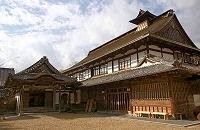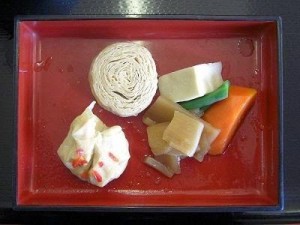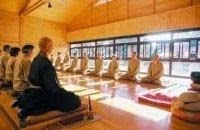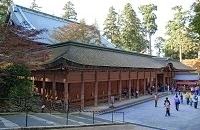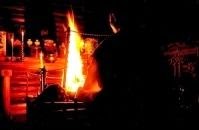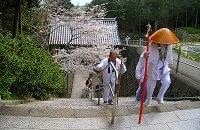Splendid Buddhist Experiences in Japan
Zazen
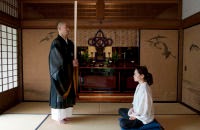 |
Zazen (坐禅; simplified Chinese: 坐禅; traditional Chinese: 坐禪; pinyin: zuò chán) literally means “seated meditation.” It is a meditative discipline primarily associated with Zen Buddhism. You can experience this meditation at the Sōtō-shū, Rinzai-shū and Tendai-shū temples throughout Japan.The two major Zen Buddhism sects, Sōtō-shū and Rinzai-shū, have different style of zazen. In Sōtō-shū, practitioners sit facing a wall and try to achieve a state in which the mind has no object at all. This is known as shikantaza. In Rinzai-shū, on the other hand, zazen is usually associated with the study of koans(公案), a story, dialogue, question, or statement, which is used in Zen practice to provoke the “great doubt,” and test a student’s progress in Zen practice.At Shingon-shū temples you can also experience another other style of meditation called ajikan (阿字観). Ajikan is a meditative discipline of Vajrayana known as Tantric Buddhism.For beginners, we recommend the practices at Sōtō-shū temples which provide beginner courses and one-day experience. Wikipedi: Zazen Soto-shu: How to do Zazen Rinzai-shu: What is Zazen Shingon-shu: Ajikan |
Shakyō
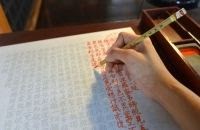 |
Sūtra copying is considered a merit in Buddhism. Other meritorious practices include the memorization and recitation of sūtras. Each Japanese Buddhist sects uses different sūtras for practice. The effort of sūtra copying is considered an expression of piety, and recognized as a devotional practice, since it comprises worship, literature, and calligraphy.The most popular sutra for shakyō practice in Japan is Hannyashinkyō (般若心境; literally “heart sūtra”; Sanskrit: Prajñāpāramitāhṛdaya), which consists of only 276 Chinese characters, or kanji, and is a good practice for beginners. You can practice shakyō using Hannyashinkyō at the temples of Tendai-shū, Shingon-shū, Jōdo-shū, Rinzai-shū, Sōtō-shū, and Hōsō-shū. Wikipedia: Shakyō Wikipedia: Heart Sūtra |
Shukubō (Temple Stay)
Vegetarian Buddhist Cuisine (Yakuzen Cuisine or Shōjin Cuisine)
 |
At a shukubō, you can experience the Japanese Buddhist cuisine also known as yakuzen (薬膳料理) or shōjin (精進料理). Buddhist cuisine is an East Asian cuisine which is followed by clergy and many believers from areas historically influenced by Buddhism.In Kyoto, several restaurants specialize in Buddhist cuisine. At these restaurants, you can experience kaiseki (懐石), traditional multi-course vegetarian Japanese dinner. Wikipedia: Buddhist Cuisine Wikipedia: Kaiseki |
| Yuba (湯葉) Tofu skin, yuba, bean curd skin, bean curd sheet, or bean curd robes is a food product made from soybeans. During the boiling of soy milk, in an open shallow pan, a film or skin forms on the liquid surface. The films are collected and dried into yellowish sheets known as tofu skin. Since tofu skin is not produced using a coagulant, it is not technically a proper tofu; however, it does have similar texture and flavour to some tofu products.It was introduced by the monk Saichō, the founder of Tendai-shū Buddhism school from China and know as one of the major ingredients of Buddhist cuisine. |
88 Temples (Shikoku Pilgrimage)
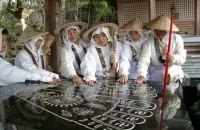 |
Shikoku Pilgrimage (四国遍路 Shikoku Henro) or Shikoku Junrei (四国巡礼) is a multi-site pilgrimage of 88 temples associated with the Buddhist monk Kūkai (Kōbō Daishi), the founder of Shingon-shū, on the island of Shikoku. A popular and distinctive feature of the island’s cultural landscape, and with a long history, large numbers of pilgrims (known as henro) still undertake the journey for a variety of ascetic, pious, and tourism-related purposes. The pilgrimage is traditionally completed on foot, but modern pilgrims use cars, taxis, buses, bicycles, or motorcycles. The standard walking course is approximately 1,200 km (750 miles) and can take anywhere from 30 to 60 days to complete. Wikipedia: Shikoku Pilgrimage Tourism Shikoku: Shikoku Henro |
Model Tours
We can organize tailor made tours according to your interests and preferences. Please feel free to contact us and we will provide you the best possible itinerary.
● Zen Experience and Shukubō Stay 6 Nights 7 Days
| Otsutome (お勤め) or Gongyo (勤行) Otsutome is a Buddhist liturgy performed at Buddhism temples everyday morning. It is a set form of ceremony or pattern of worship. The contents depends on and varies according to the schools but usually consists of chanting, playing, sūtra reading and studying the philosophy.In Sōtō-shū school, the monks and devotees practice zazen for 15 to 20 minits until a fire lit incense disappears. In Rinzai-shū school, people participate in the cleaning together with monks after zazen practice also. |
● Japanese Buddhism Training at Tendai-shu Mount Hiei 5 Nights 6 Days
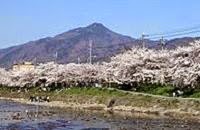 |
Mount Hiei is a mountain to the northeast of Kyoto. Enryaku-ji, the first center of the Japanese Tendai-shū sect of Buddhism, was founded atop Mount Hiei in 788 AD. Almost all Japanese monks in classical times studied at Mount Hiei. This program provide Japanese Buddhism Training at this historical sight.
|
| Japanese Buddhism History and Mount Hiei (比叡山) Since the Japanese monk Saichō established a simple hut on this mountain, many great priests have been trained and educated in this holy mother mountain. This magnificent green mountain is now starting to glow with a new brilliance as a great cultural asset generated by mankind upon a foundation of 1,200 years of history. In December 1994, the registration of Hieizan Enryaku-ji as a World Cultural Heritage Site was approved by UNESCO’s Convention Concerning the Protection of the World Cultural and Natural Heritage.Hieizan Enryakuji |
● Discover Japanese Esoteric Buddhism Mount Kōya & Kyoto Free Plan 5 Nights 6 Days
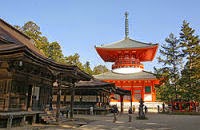 |
Kōyasan or Mount Kōya is a sacred place for Japanese Buddhism, founded in the Heian Period by Kūkai (Kōbō Daishi), the founder of Shingo-shū. Mount Kōya is known as a center of Shingon-shū.
|
| Gomataki (護摩焚き) or Goma-hoyo (護摩法要) The word Goma (護摩) originates from the Sansckrit homa, also known as homam or havan, which refers to any ritual in which making offerings into a consecrated fire is the primary action. Such a ritual of consecrated fire is unique to Vajrayāna and Esoteric Buddhism in Japan, and is perhaps also the most mystical and cognitively powerful of Japanese Buddhist practices. It stems from the Vedic Agnihotra Ritual and is performed by qualified priests for the benefit of individuals, the state, or all sentient beings in general. The consecrated fire is believed to have a powerful cleansing effect spiritually and psychologically. It is believed that the homa ritual of Vedism was included in the process of the development of Mahāyāna Buddhism. |
● Ohenro (88 Temples) Course
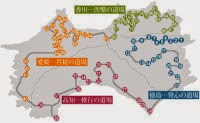 |
The Shikoku pilgrimage route (also called “O-Shikoku”) is one of the few circular-shaped pilgrimages in the world. It includes 88 “official” temples and numerous other sacred sites where Kūkai (Kōbō-Daishi) is believed to have trained or to have spent time during the 9th Century.If walked, the entire route is about 1,200 kilometers, which allows one to experience the abundant natural surroundings of Shikoku and presents many opportunities to mix with the local people.To complete the visits of all 88 temples takes one to two months on foots. A twelve days program visiting all 88 temples by bus also can be arranged. Please feel free to contact us for further information. nippon.com: The Spiritual Pull of Shikoku’s “Henro” Pilgrimage |
| Ohenro Costume The pilgrim’s traditional costume is comprised of a white shirt (白衣 oizuru), a conical Asian hat (すげ笠 suge-kasa), and kongō-zue (金剛杖). This may be supplemented by a wagesa (輪袈裟). The henro also carries a bag (ずだ袋 zuda-bukuro) containing name slips (納札 osame-fuda), prayer beads (数珠 juzu) (also known as nenju (念珠)), a nōkyō-chō (納経帳), incense sticks (線香 senkō), and coins used as offerings (お賽銭 o-saisen). The more religiously-minded henro may also carry a book of sutras (経本 kyōbon) and go-eika (ご詠歌) set with a bell. |

